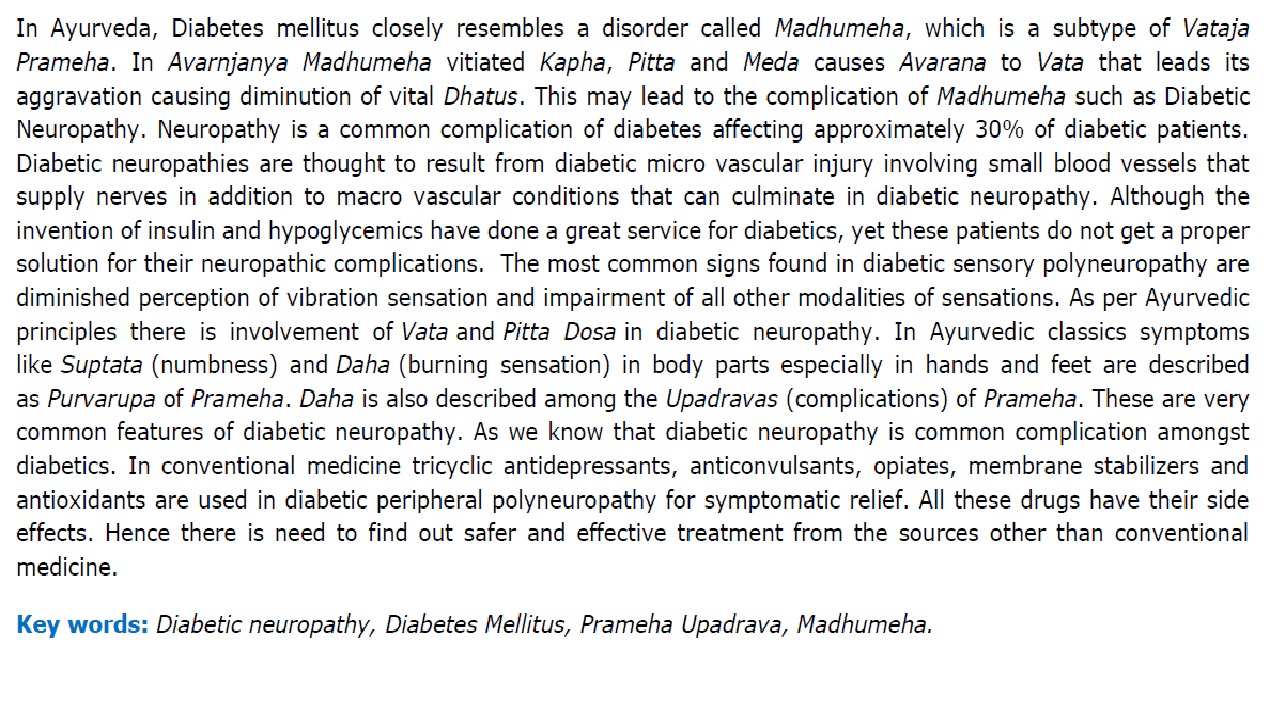Ayurvedic and modern approach to Diabetic Neuropathy : A Review
Keywords:
Ayurveda, Diabetic neuropathy, Diabetes Mellitus, Prameha Upadrava, MadhumehaAbstract
In Ayurveda, Diabetes mellitus closely resembles a disorder called Madhumeha, which is a subtype of Vataja Prameha. In Avarnjanya Madhumeha vitiated Kapha, Pitta and Meda causes Avarana to Vata that leads its aggravation causing diminution of vital Dhatus. This may lead to the complication of Madhumeha such as Diabetic Neuropathy. Neuropathy is a common complication of diabetes affecting approximately 30% of diabetic patients. Diabetic neuropathies are thought to result from diabetic micro vascular injury involving small blood vessels that supply nerves in addition to macro vascular conditions that can culminate in diabetic neuropathy. Although the invention of insulin and hypoglycemics have done a great service for diabetics, yet these patients do not get a proper solution for their neuropathic complications. The most common signs found in diabetic sensory polyneuropathy are diminished perception of vibration sensation and impairment of all other modalities of sensations. As per Ayurvedic principles there is involvement of Vata and Pitta Dosa in diabetic neuropathy. In Ayurvedic classics symptoms like Suptata (numbness) and Daha (burning sensation) in body parts especially in hands and feet are described as Purvarupa of Prameha. Daha is also described among the Upadravas (complications) of Prameha. These are very common features of diabetic neuropathy. As we know that diabetic neuropathy is common complication amongst diabetics. In conventional medicine tricyclic antidepressants, anticonvulsants, opiates, membrane stabilizers and antioxidants are used in diabetic peripheral polyneuropathy for symptomatic relief. All these drugs have their side effects. Hence there is need to find out safer and effective treatment from the sources other than conventional medicine.
Downloads
References
The effects of improved glycemic control on complications in type 2 diabetes. Gaster B, Hirsch IB Arch Intern Med. 1998 Jan 26; 158(2):134-40.
Diabetic neuropathy, (cited on 20 july 2019) available from https://www.mayoclinic.org/diseasesconditions/diabetic-neuropathy/symptoms-causes/syc20371580
Dr. Suraj Rathod, Dr. Pratima Prabhakar Rao Surve, Dr. Vrinda P. Kadu, Dr. Ramdas B. Shinde. Concept of Diabetic Neuropathy and its management in Ayurveda. J Ayurveda Integr Med Sci 2019;4:295-299.
Llewelyn, J. Gareth. "The diabetic neuropathies: types, diagnosis and management." Journal Neurology, Neurosurgery & Psychiatry 74.suppl. 2 (2003): ii15-ii19.
American Diabetes Association. Diagnosis and classification of diabetes mellitus." Diabetes care 33. Supplement 1 (2010): S62-S69.
Singh SK, Rajoria K, Dadhich S, An Ayurvedic approach in the management of diabetic neuropathy -a case report JOA XIII-1, 2019; 150 – 154.
Prof. K.R. Srikantha Murthy editor. 1st ed, Susruta Samhita, Sutrasthan, Chapter 17, Verse 7. Vol-II.Varanasi: Chaukhamba Orientalia, 2001;pg 150.
Sharma RK and Bhagwan Dash. editor, (2nd ed.). Charaka Samhita, Sutra Sthana, Chapter 20, Verse 12,English Translation, Reprint. Vol. 1. Varanasi: Chowkhamba Sanskrit Series Office; 2009. pp. 218
Sharma RK and Bhagwan Dash. editor, (2nd ed.). Charaka Samhita, Sutra Sthana, Chapter 28, Verse 17,English Translation, Reprint. Vol. 1. Varanasi: Chowkhamba Sanskrit Series Office; 2009. pp. 267
Aacharya Vaidya Jadavaji Trikamji., editor. Agnivesha, Charaka, Charaka samhita, Nidana Sthana, Adhyaya. Varanasi: Chaukhamba Sanskrit sansthan. 2nd ed. 47. Vol. 4. Dridhabala. Varanasi: Chaukhamba Sanskrit sansthan; 1990. 325
Shukla V, editor, (2nd ed.). Charaka Samhita of charak, Chikitstasthan: Chapter 6, Verse 53. Varanasi: Chowkhambha Sanskrit Series, 2002; 261.
Shukla V, editor, (2nd ed.). Charaka Samhita of charak, Chikitstasthan: Chapter 6, Verse 15-16. Varanasi: Chowkhambha Sanskrit Series, 2002; 252.
Brahmasankar M. Bhavaprakasha Nighantu. Vidyotini Hindi commentary. Guḍuchyadivarga. 10th ed.,Vol. 190. Varanasi: Chaukhambha Sanskrit Sansthan; 2002. p.393.
Brahmanand T. Sarangdhar Samhita; Dipika Hindi commentary. Madhyakhand 9/45‑50. Varanasi: Chaukhamba Surbharati Prakashan; 2004. p. 225.
Brahmasankar Misra, editor, (10th ed.), Vidhyotini Hindi commentary on Bhav Prakash nighantu, Gudichayadivarg chapter 26 verse 41. Varanasi: Chaukhambha Sanskrit Sansthan, 2002;294.
Murthy SK, editor. Astagahridaya of Vagbhatta, Sutra Sthana; Dinacharya Adhyaya. Ch. 2, Ver. 15. Varanasi: Chaukhamba Surbharati Prakasan; 2004. p. 25.
Murthy SK, editor. Astaga hridaya of Vagbhatta, Sutra Sthana. Ch. 6, Ver. 159, 5th ed. Varanasi: Chaukhamba Surbharati Prakasan; 2004.p. 105.
https://www.mayoclinic.org/diseases-conditions/ diabetic-neuropathy/symptoms-causes/syc-20371580
Krishnanvaidyar KV, Gopalapillai S. Sahasrayogam, Tailayoga, 26th ed. Mullakkal: Vidyarambam publications; 2006. p. 308‑9.
Bhavprakash of Bhavmishra, Prof. Murthy K.R. Shrikantha, (vol.2) Krishnadas Academy, Varanasi, First edition 2000, Page no. 489.














